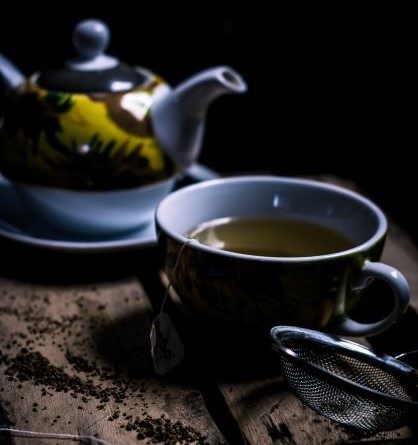Green tea is known as the elixir of youth, an anti-aging remedy, as well as a panacea for weight loss. However, like there are pros and cons to everything in life. In this blog you will find the truth about green tea and its benefits, side effects, types of green tea, and more.
Origin of Green Tea
There are many stories behind the history of green tea, but the most popular one dates back to ancient China, almost 5,000 years ago. In Chinese mythology, Emperor Shen Nung, known as the “Father of Agriculture,” is said to have discovered green tea in 2737 BC.. According to the legendary story, as he rested with his entourage outdoors, a few leaves from a wild tree wafted (accidentally fell) into his pot of boiling water. He sipped the intriguing brew, not noticing the colour change, and was immediately enchanted by its delicate flavour and refreshing effect. However, some cultural historians state that green tea’s origin dates back as far as 3000 years ago, when fresh tea leaves were chewed and eaten for recreation by the people who grew it all over Southeast Asia. It was much later that freshly plucked leaves were made to undergo processing before being steeped in hot water. In earlier times, green tea was primarily available to the highest tiers of Chinese society and was very expensive to purchase until the 14th century. Later, green tea became accessible to the general public for enjoyment and medicinal purposes. Although green tea originated in China, it has Southeast Asian roots and is now widely produced and manufactured in many Asian countries. Green tea is very popular in today’s world due to its various health benefits, detoxing properties, and moderate caffeine content.
What is Green Tea?
Even today, the word “tea” in the land of the Dragon (China) refers only to green tea, not to the general category of tea as it does in the West. According to legendary stories, the Camellia sinensis plant species first appeared in Yunnan (China). In fact, 260 of the world’s 380+ varieties of tea can be found in Yunnan.
You’d think that being green is a requirement for being classified as ‘green tea.’ While this is partially correct, technically speaking, green tea is any tea that has not been subjected to the normal production process of oxidation and withering, as is black tea.
Did you know that the popularity of green tea started with a really bad hangover? Yes, believe it or not, it was centuries ago, when a Japanese shogun named Sanetamo (1192-1219 CE) was suffering from a terrible hangover, and everyone around him thought he was about to die. A monk named Myoan Eisai made some tea and made him drink it, which saved him. After that, Sanetamo became a tea aficionado, and he started spreading green tea across Japan.
Green tea was originally prepared very differently than it is now. The tea leaves were steamed, oven-kneaded, formed into small brick shapes, and dried. Those tea “bricks” were later cooked with rice, ginger, salt, orange peel, spices, milk, and sometimes onions. Tea is still made in this manner in Mongolia and Tibet today.
Why should you drink green tea?
Green tea is the least oxidized when processed, and that is why it is touted as the most beneficial. Organic loose leaf green tea is especially healthy because it does not contain any harmful substances. In addition, with organic loose-leaf green tea, the taste is better absorbed in the water, which leads to a subtle tea flavor. Perfect for your ultimate moment of enjoyment.
“Did you know? Green tea is considered a superfood!”
Green tea is promoted as a beverage or dietary supplement for increasing mental alertness, alleviating digestive symptoms and headaches, and promoting weight loss. Green tea and its constituents, including epigallocatechin-3-gallate (EGCG), have been studied for their potential anti-heart disease and anti-cancer properties. Green tea contains fewer calories and less caffeine than black tea and coffee. Antioxidants in it protect your cells from damage, which aids in the prevention of aging. Antioxidants abound in organic loose leaf green tea. This means you’re better protected from outside influences like UV radiation and air pollution. This lowers the risk of cardiovascular disease and a variety of cancers. Green tea’s antioxidants, along with other components, provide additional health benefits. Green tea also contains trace amounts of minerals that are beneficial to your health. Green tea also contains trace amounts of minerals that are beneficial to your health. The body is constantly under oxidative stress as a result of free radicals attacking cells. Antioxidants, such as polyphenols and vitamin C, are used by the body to combat this. Tea may promote bone formation and has been linked to a lower risk of osteoporosis fractures. Some green tea compounds may help protect against cancer and heart disease, so it can help you live longer. Catechins are found in a variety of foods, which is why nutrition quality is important. Green tea consumption on a regular basis provides an additional supply of catechins. The antioxidants in green tea are thought to delay or worsen the onset of certain diseases.
You can buy best green tea here. Bliss Tisaane brings Darjeeling Tea “The Champagne of Teas”, one of the finest teas globally. This delicate variety is grown in the foothills of the Himalayas, in the Darjeeling region. Darjeeling Green Tea is hand-picked, unfermented premium quality tea. It provides a much lighter brew than other conventional teas. Brewed tea looks clear with a beautiful golden-yellow hue. It has a unique “muscatel” flavor and after taste that will enlighten your day. This unique taste cannot be replicated anywhere else and is hence preferred by tea connoisseurs around the world.

